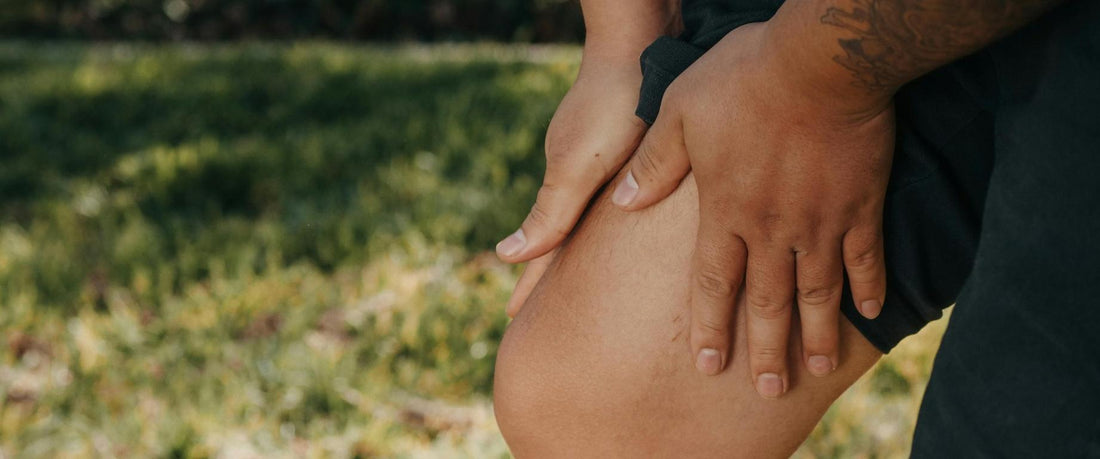
Joint discomfort is no longer an issue limited to older adults. Increasingly, younger people notice subtle signs—knees feeling sore after a walk, slight resistance when climbing stairs, or mild pulling sensations during workouts. These experiences may not stem from bone or cartilage damage but from low-grade chronic inflammation within the soft tissues of the joints.
Why the Knee Is a High-Risk Area
The knee is one of the most common sites for chronic inflammation due to its complex structure and heavy daily workload.
- Inflammation as a repair mechanism: Normally, the immune system responds to stress or minor injury by repairing tissue damage. When this process lingers, it becomes long-lasting low-grade inflammation.
- Lifestyle triggers: Prolonged sitting, slouching, leg crossing, and repeated strain create continuous stress on knee tissues. Over time, small triggers accumulate and inflammation persists.
How Chronic Inflammation Affects the Knee
1. Disrupts lubrication and movement
- Pro-inflammatory molecules (e.g., TNF-α, IL-1β) interfere with synovial fluid secretion.
- Leads to swelling, stiffness, thickened synovium, and reduced joint space.
2. Generates free radicals
- Produces reactive oxygen species (ROS), which act like “chemical knives.”
- Damages cell membranes, proteins, and collagen fibers in synovium and cartilage.
- Reduces elasticity of ligaments and tendons, impairing repair capacity.
3. Increases nerve sensitivity
- Activates sensory receptors, lowering the threshold for discomfort.
- Normal activities may trigger tightness, mild pain, or reduced flexibility.
Why Rest Alone Is Not Enough
While rest can temporarily ease pressure on the knees, inflammation often continues in the background. True recovery requires a multi-faceted approach:
- Balanced nutrition: Diets high in sugar and fat sustain pro-inflammatory states. Antioxidant-rich vegetables, fruits, and whole grains may help reduce triggers.
- Moderate exercise: Strengthening quadriceps and gluteal muscles reduces knee load. Even brisk walking or bodyweight squats can support stability.
- Posture correction: Avoid long periods of sitting, kneeling, or leg crossing. Regular movement supports circulation and joint balance.
- Targeted intervention: Certain bioactives, such as curcumin, have been studied for their ability to regulate inflammatory pathways. Research shows curcumin can inhibit NF-κB signaling, reduce TNF-α and IL-1β release, and provide antioxidant support (Hewlings & Kalman, 2017; Deng et al., 2022).
Science Meets Innovation: BIGVITA® CoCrystal Curcumin
BIGVITA® CoCrystal Curcumin applies advanced supramolecular co-crystal technology to improve curcumin’s solubility and absorption. This innovation addresses the bioavailability challenge seen in standard curcumin, offering a gentler, more sustainable option for daily joint health support.
References
1. Berenbaum, F. (2013). Osteoarthritis as an inflammatory disease (osteoarthritis is not osteoarthrosis!). Osteoarthritis and Cartilage, 21(1), 16–21. https://doi.org/10.1016/j.joca.2012.11.011
2. Deng, Z., Zhang, L., Wang, Y., et al. (2022). The anti-inflammatory role of curcumin in knee osteoarthritis: A narrative review. Frontiers in Medicine, 9, 871122. https://doi.org/10.3389/fmed.2022.871122
3. Greif, D. N., Kuhn, K. M., & Williams, R. J. (2020). The infrapatellar fat pad/synovium complex: A dynamic regulator of knee osteoarthritis. Frontiers in Bioengineering and Biotechnology, 8, 860. https://doi.org/10.3389/fbioe.2020.00860
4. Hewlings, S. J., & Kalman, D. S. (2017). Curcumin: A review of its effects on human health. Foods, 6(10), 92. https://doi.org/10.3390/foods6100092
5. Malfait, A. M., & Schnitzer, T. J. (2013). Towards a mechanism-based approach to pain management in osteoarthritis. Nature Reviews Rheumatology, 9(11), 654–664. https://doi.org/10.1038/nrrheum.2013.138
6. Mathiessen, A., & Conaghan, P. G. (2017). Synovitis in osteoarthritis: Current understanding with therapeutic implications. Arthritis Research & Therapy, 19(1), 18. https://doi.org/10.1186/s13075-017-1229-9
7. Scanzello, C. R., & Goldring, S. R. (2012). The role of synovitis in osteoarthritis pathogenesis. Bone, 51(2), 249–257. https://doi.org/10.1016/j.bone.2012.02.010
8. Zeng, N., Yan, Z. P., Zhang, Y., et al. (2020). Infrapatellar fat pad and knee osteoarthritis. Aging and Disease, 11(6), 1317–1328. https://doi.org/10.14336/AD.2020.0310